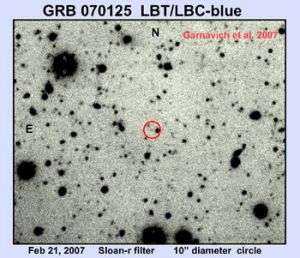First science from the Large Binocular Telescope

An international team headed by University of Notre Dame astrophysicist Peter M. Garnavich has reported the first scientific result from the Large Binocular Telescope (LBT). The team imaged a distant “afterglow” of gamma ray burst “070125.”
The $120 million LBT is located atop Mount Graham, a 10,700-foot mountain in southeastern Arizona. The team of observers used the LBT’s “left-side” primary mirror and its “blue” camera to capture a detailed image of the afterglow of the gamma ray burst.
Gamma ray bursts are huge blasts of gamma rays that last for seconds or minutes. The blasts drive shocks into the surrounding gas that generate light from X-rays to radio waves and these “afterglows” are visible for just a few hours to a few days. The explosions are distant, often more than halfway back to the Big Bang. GRB 070125 was more than 7 billion light years away.
Garnavich’s team observed the gamma ray burst Feb. 21, almost a month after it exploded. The detection caught the burst at 26th magnitude. The magnitude scale is used by astronomers to measure the brightness of objects in space. The human eye can detect stars as faint as the 6th magnitude on a clear, dark night. The LBT was able to see a source that was 100 million times fainter than the limit of human vision.
“I have never before observed anything from the ground at the 26th magnitude and the seeing conditions at the LBT were not ideal at the time of the gammas ray burst observation, so we can, and will, go even deeper with this telescope,” Garnavich said.
The visible light of the gamma ray bursts afterglows are critical in understanding how gamma rays are generated in bursts. By following the optical decay, astrophysicists have been able to show that the energy comes out in a narrow beam and the bursts are only seen if the beam is aimed at the Earth.
“By studying the fading afterglow light, we show that the blast accelerates particles to nearly the speed of light and our deep images tell us exactly the opening angle of the jet aimed in our direction,” Garnavich said.
Garnavich was a member of a team of astronomers that in 2002 helped solve the mystery of one kind of gamma ray burst. The researchers found that the long blasts occur when stars explode and their cores collapse to form black holes. GRB 070125 probably created a black hole in a supernova collapse, but it is too distant to detect the explosion.
The LBT is unlike any other telescope because it uses twin 8.4-meter (27.6-foot) honeycomb mirrors that sit on a single mount, allowing it to view with the sharpness of a 23-meter telescope. The LBT achieved “first light,” or the first images of the night sky, in 2005 after the left mirror (called SX for “sinistra,” or left, in Italian) was installed and the blue-sensitive camera was taking pictures. The telescope is expected to be fully operational, with both of its enormous eyes wide open, later this year.
The LBT was built by an consortium that includes scientists from Notre Dame, the University of Arizona, Italy’s Istituto Nazionale di Astrofisica, Germany’s LBT Beteiligungsgesellschaft (representing the Max Planck Society), the Astrophysical Institute Potsdam, Heidelberg University, Ohio State University, the Universities of Minnesota and Virginia, and the Research Corporation.
Source: University of Notre Dame



















